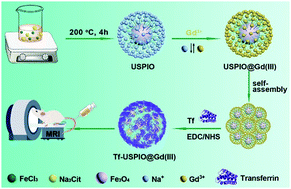A cation exchange strategy to construct a targeting nanoprobe for enhanced T1-weighted MR imaging of tumors†
Abstract
Excellent imaging performance and good biocompatibility of contrast agents are considered as prerequisites for accurate tumor diagnosis. In this study, a novel imaging nanoprobe with actively targeting performance based on ultrasmall paramagnetic iron oxide (USPIO) nanoparticles was constructed by a facile cation exchange strategy followed by conjugation with transferrin (Tf). The stable gadolinium (Gd3+) chelation endows the nanoparticles (NPs) with a low value of r2/r1 (1.28) and a relatively high r1 value of 3.2 mM−1 s−1, enabling their use for T1-weighted positive magnetic resonance (MR) imaging. This constructed transferrin modified gadolinium-iron chelate nanoprobe, named as TUG, shows high biocompatibility within a given dose range. More importantly, compared with clinically used Gd-based small molecule contrast agents, the obtained TUG can be more engulfed by breast cancer cells, showing much enhanced T1-weighted positive MR imaging in both subcutaneous and orthotopic tumor models of breast cancer. This novel nanoprobe holds great promise to be utilized as a targeting contrast agent with high efficacy for T1-weighted positive MR imaging.

- This article is part of the themed collection: Journal of Materials Chemistry B HOT Papers


 Please wait while we load your content...
Please wait while we load your content...